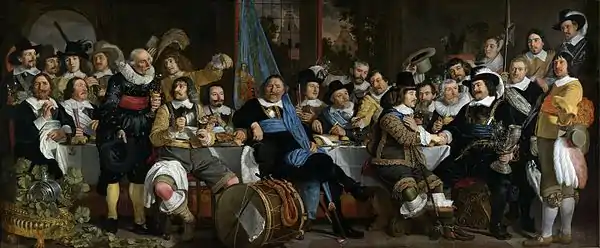Banquet of the Amsterdam Civic Guard in Celebration of the Peace of Münster
Banquet of the Amsterdam Civic Guard in Celebration of the Peace of Münster (1648) is a group portrait oil painting by the Dutch painter Bartholomeus van der Helst. It is an example of Dutch Golden Age painting and is considered one of the highlights of the Amsterdam Museum, though it is generally on show in the Rijksmuseum.

| Banquet of the Amsterdam Civic Guard in Celebration of the Peace of Münster | |
|---|---|
.jpeg.webp) Cornelis Witsen, heading the table and holding a guild cup, shakes Johan van Waveren's hand for peace | |
| Artist | Bartholomeus van der Helst |
| Year | 1648 |
| Dimensions | 232 cm × 547 cm (91 in × 215 in) |
| Location | Rijksmuseum, Amsterdam |
| Accession | SK-C-2 / SA 7378 |
| Website | Rijksmuseum Amsterdam Museum |
The painting is one of the largest civic guard group portraits for which most of the sitters are known and most of the portrayed objects have survived.
The painting is about retiring from active duty, because the Peace of Münster had finally been signed after years of negotiations. The main figures are seen with the attributes of the civic guard guilds. On the right Cornelis Jan Witsen heads up the table, holding the silver drinking horn of the Voetboogdoelen, Amsterdam.[1]
 The "bekerschroef" or wineglass holder, is one of five still in the collection of the city of Amsterdam[2]
The "bekerschroef" or wineglass holder, is one of five still in the collection of the city of Amsterdam[2].jpg.webp) The silver drinking horn was painted by Van der Helst again in 1656 when he painted the directors of the Voetboogdoelen
The silver drinking horn was painted by Van der Helst again in 1656 when he painted the directors of the Voetboogdoelen
The art historian J.J. de Gelder mentioned the painting is dated 1648 but was probably finished at least a year later, similar to the way other group portraits by Van der Helst bear the date of the commission and not of completion.[3] The drum explains the occasion by way of the poem attached to it by Jan Vos. The names mentioned in the poem are the handshakers, but in 1680 a name board was added that included 24 names:
| column 1 | column 2 | column 3 | column 4 | column 5 | column 6 |
|---|---|---|---|---|---|
| Hendrik Calaber | Jan Maesz | Cornelis Jan Witsen, Captain | Johan van Waveren, Lieutenant | Geurt Pieter van Anntenraat | Hendrik Dommer Wz |
| Govert van der Mij | Jacob van Diemen | Jacob Banning, Ensign | Thomas Hartog, Sargeant | Herman Theunisz. de Kluyter | Paulus Hennekyn |
| Johannes Calaber | Jan van Ommeren | Dirck Claesz Thoveling, Sargeant | Willem Pietersz. van der Voort | Andries van Anntenraat | Lambert van den Bos |
| Benedictus Schaeck | Willem de Tamboer | Pieter van Hoorn | Adriaen Dirck Sparwer | Christoffel Poock | Isaac Oyens |
The art historian Judith van Gent remarked that the first name on this list was Hendrik Caliber who was buried a month after the festivities took place, and agrees with De Gelder that the painting took quite a while to create and assumes the commission probably was granted well before the summer of 1648. In her catalog entry for this painting she lists short biographies of the traceable names.
References
- KA 13965 Drinking horn on Amsterdam Museum website
- KA 13969 Bekerschroef on Amsterdam Museum website
- J.J. de Gelder, dissertation on Bartholomeus van der Helst with a monograph of his work, 1921, cat. nr. 836
- Judith van Gent, Bartholomeus van der Helst (ca. 1613-1670). Een studie naar zijn leven en werk', Waanders, Zwolle, 2011, nr. 43
